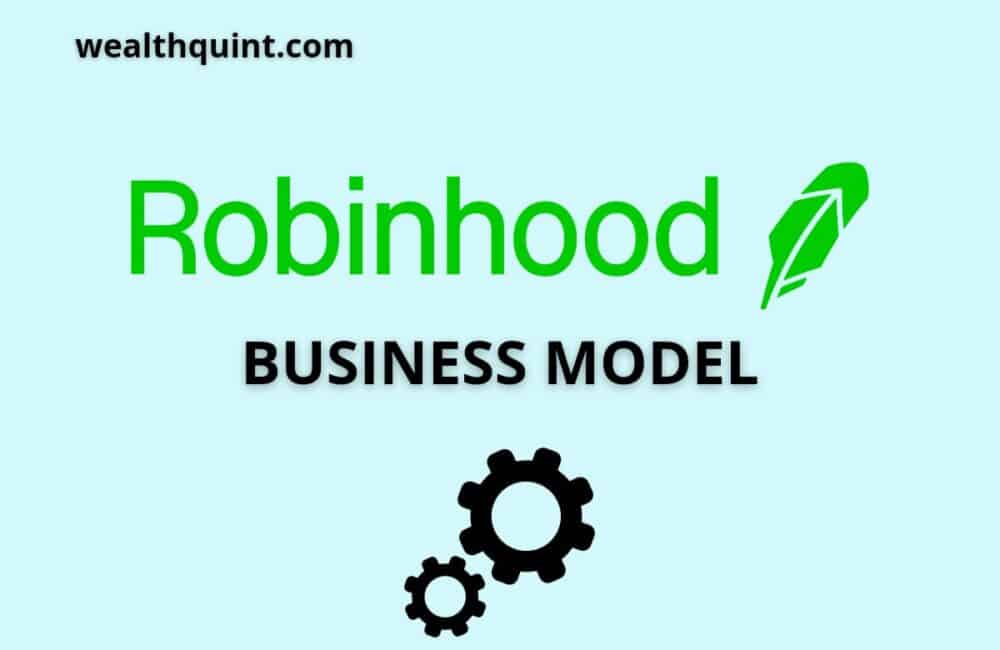Robinhood is one of the leading platforms for all sorts of trading, investments, or services related to cryptocurrency.
The platform has evolved over years strictly according to the needs and demands of the users. However, the platform stands in the top commission-free platforms for investing and trading, some of the investment enthusiasts wonder how they work out their finances.
Robinhood runs on a fixed and very organized business model. This allows it to be commission-free for the users and manage their income sources simultaneously.
With over thousands of investment options such as EFTs, Cryptocurrency, mutual funds, etc. Robinhood also allows different tiers of accounts for you to utilize and manage your assets.
Basic Sources Of Income For Robinhood
As we all know, apart from their general account, the Robinhood team offers a large variety of premium accounts. Believe it or not, these accounts are a basic source of profit for the platform.
However, the majority of business is made by this tool, there are two other ways in which Robinhood seeks business.
Coming to the very first way of earning through the platform, the gold and instant accounts. Certain interesting accounts yield a good business value for the platform.
However, the second basic way is to provide premium features at a cost that are better and can be called the advancements of the existing work. The third primary source is by making and charging a fair amount of market-making fees.
How Robinhood Makes Money?
Robinhood has made finances easy for everyone. They offer different features to the user including zero-commission trading. The different ways in which Robinhood generates its revenue:
- Robinhood Gold
- Cash Management
- Income generated from cash
- Stock loan
- Rebates from market makers
Let’s discuss all these factors in detail.
Robinhood Gold
Robinhood gold can be defined as the type of premium Robinhood account that offers you more features than a regular account. But for those features, you will have to pay for a premium account.
One of the best features that it has to offer is margin investing. It implies that even if you are short on money, you can invest on margin using Robinhood securities.
Moreover, if you ine=vets more than 1000$ in margin trading, you will be liable to pay 2,5% per annum interest on the amount used above 1000$.
Stock Loans
Another method in which Robinhood earns money is by lending securities on margin to the counterparty.
Market Makers Rebates
So, when you choose to sell or buy stocks, options, or ETFs via your brokerage account, your orders will be sent to different exchanges and market makers.
Therefore, the exchanges will make a rebate for the brokerage so that they choose them for the order. Market makers sometimes offer you better options than exchange.
Robinhood Cash Management
Robinhood debit cards are issued by Sutton Bank and they charge an interchange fee. This fee is then transferred to Robinhood financial.
This fee is earned from the credit and debit card issuers and covers important aspects like fraud loss and transaction processes. Moreover, they also receive some fees from the bank to provide funds to them.
Cash Income
So, the last way in which Robinhood makes money is income from cash. This income is generated from the cash which is not invested and is not provided to the program banks.
3 Major Pillars Of Robinhood Business Model
So, now that you know how Robinhood makes money, here are the three major pillars of its business model. The three major pillars of the Robinhood Business model are discussed below with their elaboration and detailed information on how it works out for Robinhood.
The Interest Accounts
For all the Robinhood accounts with a certain amount of uninvested cash, there are many investment opportunities and ways. Robinhood allows you to invest your free cash which engages your available cash and also benefits Robinhood.
Once you invest your cash, Robinhood gets a small yet considerable amount of profit from every portion you invest in any of the given investment opportunities.
These are the interest accounts or interest-making accounts on Robinhood as it becomes a source of earning interests on investment.
Freemium Model Of Income
The Freemium model allows the different companies and platforms to provide free services to the users and use it as bait to stay on the platform.
It allows the users to generate a better understanding of the company or the platform. Once these customers are well acquainted with the platform, they turn into potential leads for paid services.
Robinhood offers many services on the basic accounts, however, it offers more on the advanced accounts. Named Robinhood gold, this account gives all sorts of possible services to the account holders such as buying on margin.
This comes at a fair cost implemented by the Robinhood platform itself. These Robinhood gold account holders are one of the major pillars in the income structure of Robinhood.
Marketing Fee
Marketing fee or the fee paid by companies to forward their trade amongst the account holders on Robinhood is one of the important shares of business by Robinhood.
This is the interest or the fee asked by Robinhood in exchange for pushing forward or recommending a certain trade.
By processing these trades on their platform, Robinhood gets a share of selling and hence it is counted amongst the earning sources of the platform.
The fee might be small, but there are plenty of market makers who are more than happy to pay this fee for selling out or processing their trade on the Robinhood platform.
The platform has millions of users which is a rather good audience for the market makers and hence, they are interested to pay this market-making fee stated by Robinhood.
Other Ways For Robinhood To Generate Business
Robinhood uses various models to generate business. It is a commission-free platform for trading and investment. How Robinhood can generate good business include
- Small revenue streams
- The membership fee to join Gold accounts
- Order flow-related payments
- Fee-related to debit cards and exchange
- Revenue from cryptocurrency exchange
- Cash investment interests from various accounts etc.
These factors combine to make a good overall business for Robinhood and pay off its worth in the market.
The Financial Significance Of Robinhood
Robinhood provides a detailed report of its quarterly and annual transactions in a financial year.
It gives an outline of the profit, net worth, losses, and compensations in the company during the period. Robinhood released its last quarterly report in December end of 2021.
It indicated a total income of 13 million dollars exclusive of the losses that Robinhood Bore in the prior quarter.
The total expenses as indicated by Robinhood reached up to 318 million dollars along with the compensations in the financial year.
Another reason for relatively higher expenses in the financial year made by
Robinhood increased exponentially due to its expansion. The Robinhood team expanded up to its 150% capacity in the following financial year causing the expenses to hike.
However, with this investment, the Robinhood account users increased up to 48%YOY giving the appropriate or even more expenses back to the Robinhood team.
Revenue Contribution To Robinhood Business
Revenue from different processes and sectors is one of the major constituents of the Robinhood business model. There are different forms and types of revenues collected by Robinhood throughout the financial year.
Different processes yield different revenues for the Robinhood platform. There are two major types of revenues generated by different processes on Robinhood, namely, transaction-based and net interest-based revenues.
However, the other form of revenue offers a huge percentage of contribution in the Robinhood team income.
To understand the business segments of the Robinhood business model, it is important to understand three of these revenues in a brighter light. Therefore, below are the details of revenue breakup in the account book of Robinhood along with their application.
Also Read: Robinhood Options Explained
Detailed Revenue Contribution To Robinhood Business
Transaction-Based Revenue
Transaction-based revenue makes up 72% of the total revenue generated by Robinhood. Revenue generated by putting out certain trades and making the market to these trades comes under the transaction-based revenue.
The Robinhood app allows the users to process trades and for which it collects the revenue in the form of payment for order flow.
It is the major segment of the total revenue generated from processes under Robinhood. According to the last report given by Robinhood regarding their financial activities and status, Robinhood managed to generate around 360 million dollars from transaction-based revenue.
It is equivalent to raising the total net worth by a significant 12% and making 73% of the total company generated revenue.
Net Interest Revenue
Net interest revenue is generated by Robinhood with help of certain procedures and processes. Robinhood allows lending transactions which majorly contributes to its net interest revenue.
Net interest revenue is also highly affected by contributions of the loan seekers and company credits under the Robinhood business team.
Robinhood generates a good net interest revenue from the loans on the users by making a profit off the margins. Also, the companies affiliated with Robinhood contribute to the credit facilities.
Robinhood managed to drag Net interest revenue to 0.5% of the total worth of the company which was equivalent to about 60 million dollars. However, the net interest revenue contributes a good 17% to the total overall revenue generated by Robinhood.
Other Revenues
Last but not the least, the other revenues mostly consist of the capital generated by the fee of gold membership in the Robinhood business.
The Robinhood app provides different levels of accounts to the users and hence, provides better services at better prices. This increased price for a gold membership and advanced services is the Robinhood business margin which is counted in the other revenues generated by Robinhood.
Other than gold membership fees, the other revenues include miscellaneous fees Or charges given by the account holders for a particular trade or service on the platform.
Also, the rebates collected from the users have complied in the other revenues category of the Robinhood business model.
However, with the increased reach of Robinhood, the number of paid members on the platform has increased in a very positive graph.
This resulted in the rise of 84% in the other revenues making a business of around 34 million dollars in the 2021 financial year.
Also, its contribution to the total revenues generated by Robinhood has increased to an impressive number of 19%. Which is more than any year since Robinhood has started generating these revenues.
Conclusion
The Robinhood business model stands on three pillars. However, these are the revenue-generating models with appropriate significance on the revenue chart of Robinhood.
The Robinhood business model allows it to get a good margin without applying external charges on the users of the Robinhood platform. This results in the development of Robinhood to extend its parameters to crypto-generated revenues on a larger scale.
To know more about such topics, stay tuned to our website. We will bring new updates for you regularly.



